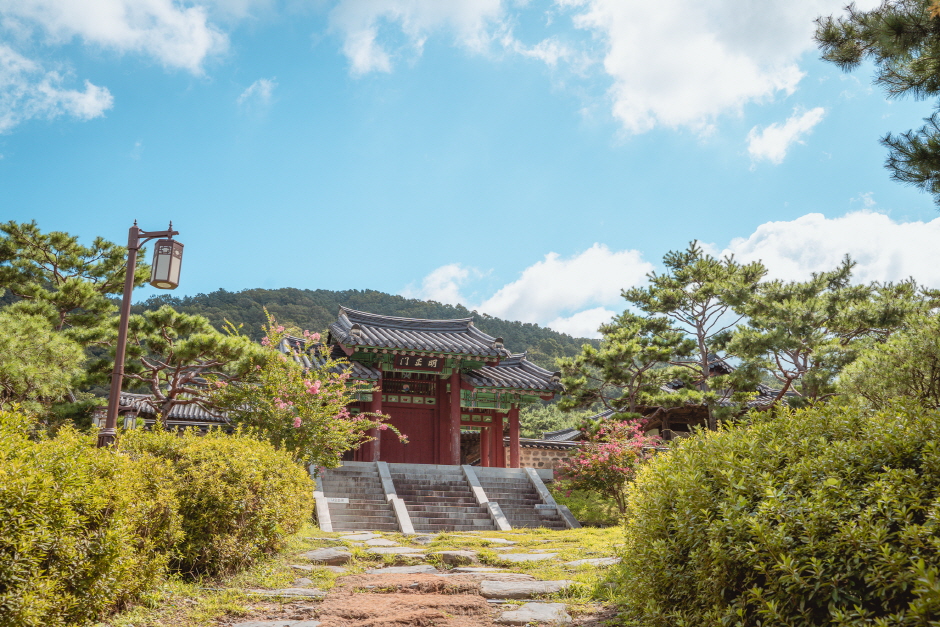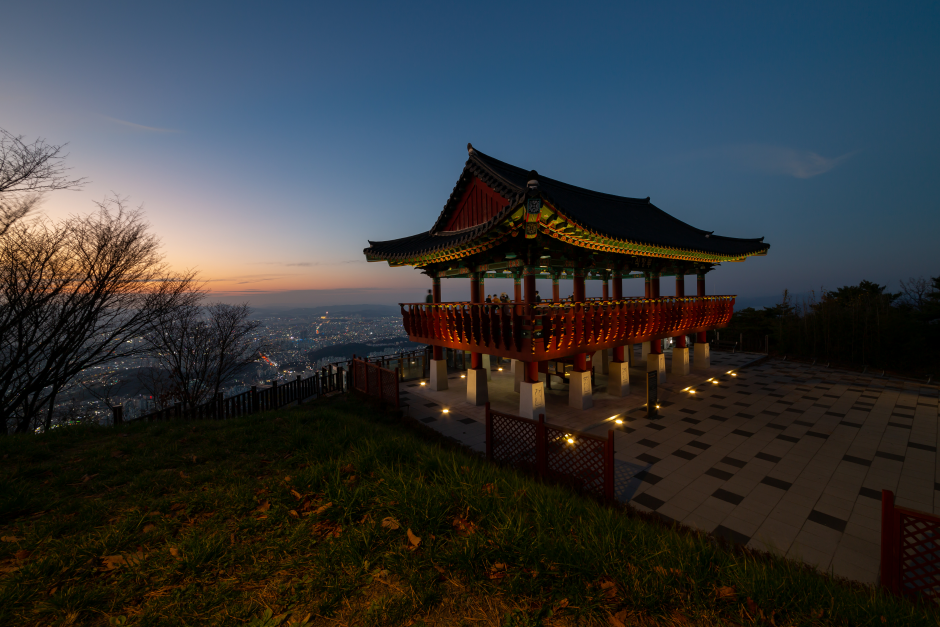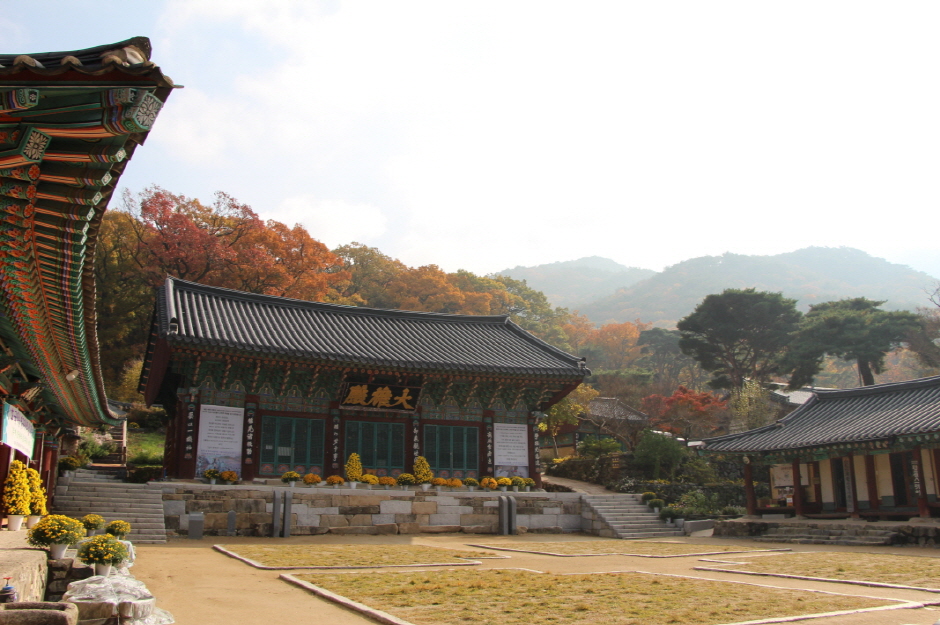Gilsang (길상)
13.0 Km 3247 2024-02-14
43 Jeonmin-ro 6beon-gil, Yuseong-gu, Daejeon
Café Gilsang, a haven for classical music enthusiasts, offers pour-over coffee made with in-house roasted beans. The café's walls are adorned with a collection of 2,000 vinyl records, showcased like art pieces. Adding to the charm are the vacuum tube amplifiers and vinyl turntables prominently displayed at the bar. It's an ideal spot for enjoying a book accompanied by classical tunes.
Uam Historical Park (우암사적공원)
13.0 Km 11193 2024-02-29
53 Chungjeong-ro, Dong-gu, Daejeon
+82-42-673-9286
Uam Historical Park, situated in the eastern part of Daejeon, is both a cultural heritage site and a park. It was once the place where Uam Song Siyeol (1607-1689), a scholar and government official during the Joseon dynasty, conducted his research and educational activities. The traditional houses established during his time and the relics left by Song Siyeol are still preserved, and visitors can view these artifacts at the historic museum. The park also features a pond within its premises.
Conto (꽁뚜식당)
13.4 Km 9 2024-02-15
111 Sintanjin-ro 36beon-gil, Daedeok-gu, Daejeon
Conto is a Chinese restaurant specializing in Bukgyeong ori (grilled Beijing duck). Guests can enjoy the lightly greasy and flavorful grilled duck cooked in a oven. The restaurant provides options for both individual Bukgyeong ori dishes and a set course menu. Given the extended preparation time for the dishes, making a reservation prior to visiting is recommended. Located near a pond, Conto offers a charming atmosphere that enhances the dining experience.
Yeonsan Halmeoni Sundae (원조연산할머니순대)
13.5 Km 18633 2024-02-28
1525 Hwangsanbeol-ro, Yeonsan-myeon, Nonsan-si, Chungcheongnam-do
Yeonsan Halmeoni Sundae is a sundae specialty restaurant located near Yeonsan Market. It has been passed down for four generations, insisting on the traditional taste. The representative menu is sundae gukbap (sundae and rice soup), which puts sundae and various internal organs in a milky broth. The broth is made by boiling pork bones, and the sundae is handmade using only pure pork blood and green onions. They also offer a sundae jeopsi (assorted sundae) and ttaro gukbap (rice and soup).
Gyeryongsan Mountain Sanshinje Festival (계룡산 산신제)
13.6 Km 3273 2020-07-29
Gyeryong-myeon, Gongju-si, Chungcheongnam-do
• 1330 Travel Hotline: +82-2-1330 (Korean, English, Japanese, Chinese) • For more info: +82-10-5807-4344
Gyeryongsan Mountain Sanshinje Festival is an annual traditional ceremony to worship and celebrate the mountain spirits. The ceremony draws many visitors thanks to the beautiful spring scenery of Gyeryongsan Mountain. There are also many attractions and traditional performances during the event. Yanghwa-ri Village, the main venue of the festival, is where the heritage and culture of Sanshinje ceremony are well preserved.
Solbat Mukjip (솔밭묵집)
13.7 Km 7 2024-02-14
51 Gwanyong-ro, Yuseong-gu, Daejeon
Solbat Mukjip is a restaurant celebrated for its 40-year tradition in crafting dotorimuk (acorn jelly salad), a culinary specialty of Daejeon. The city is so famed for its acorn jelly that it hosts an acorn jelly village. The restaurant's standout dish is chaemuk (chilled acorn jelly and rice soup), a delightful blend of chopped acorn jelly immersed in broth and garnished with sour chopped kimchi, sesame oil, laver flakes, and roasted sesame powder. The combination of the nutty acorn jelly salad with the tangy broth creates a uniquely delicious flavor. Additionally, the thinly batter-fried acorn jelly is a popular choice. This dish is served with a side of refreshing radish water kimchi and other accompaniments.
63beon-gil (63번길)
13.7 Km 0 2024-02-28
21 Gwanyong-ro 63beon-gil, Yuseong-gu, Daejeon
63beon-gil is a Korean restaurant situated near Daedeok Techno Valley, renowned for its gomtang (beef bone soup). This soup is crafted by simmering Korean beef brisket and chuck eye roll for an extended duration. The menu showcases various dishes incorporating Korean beef, such as gomtang, yukhoe (beef tartare), and yukhoe bibimbap (beef tartare bibimbap). Moreover, the establishment features a gallery and café on the second floor for visitors to enjoy.
Sikjangsan Cultural Park (Sunrise Observatory) (식장산 문화공원(해돋이전망대))
13.8 Km 35273 2023-02-09
32-834, Secheongongwon-ro, Dong-gu, Daejeon
Sikjangsan (623.6 meters) is a mountain spanning three regions - Dong-gu of Daejeon, Gunbuk-myeon and Gunseo-myeon of Okcheon-gun. As the tallest peak in the city located in the southeastern part of Dong-gu, Daejeon, it stands proudly next to great mountains in neighboring regions such as Seodaesan, the tallest peak in Chungcheongnam-do (904 meters), and Daeseongsan, the tallest in Okcheon (705 meters). Home of a 4.82 million-square-meter large, natural ecosystem preservation forest designated by the city, Sikjangsan is an ecological repository featuring plants of 224 species, 45 varieties, 187 genera, and 78 families; 45 kinds of mammals such as roe deer, squirrels, wildcats, raccoons and bats; over 100 types of birds; reptiles; and amphibians.
Sikjangsan Cultural Park is an ecological park that continues from Secheon Park to Sikjangsan Sunrise Observatory. The cultural park was established at the peak of the mountain, which had been regarded as one of the best nightscape viewpoints in Daejeon. A traditional tower built inside the cultural park adds a sense of classical dignity. An observatory from which the entire city can be seen in a single view is also located here. People of all ages and genders visit the tower and observatory to enjoy the expansive view of Daejeon.
Gapsa Temple (갑사)
14.2 Km 16096 2021-12-17
567-3, Gapsa-ro, Gongju-si, Chungcheongnam-do
+82-41-857-8981
Gapsa Temple is located in the forested foothills of Gyeryongsan Mountain, 19 kilometers from Gongju and a three-hour walk from Donghaksa Temple. The temple is most beautiful during fall when surrounded by crimson foliage. Gapsa Temple was established by monk Adohwasang in 420, during the early Baekje Period. The temple's beauty allowed it to escape destruction many times, but it was ultimately burned down during the Imjin War (1592-1598). The current structures were built in 1604. Nearby attractions include Yongmunpokpo Falls, Sujeongbong Peak, and Cheonjinbotab Pagoda.
Gapsagyegok Valley (갑사계곡)
14.8 Km 58634 2024-02-21
519 Gapsa-ro, Gyeryong-myeon, Gongju-si, Chungcheongnam-do
Gapsagyegok Valley is a valley located on the northwest slope of Gyeryongsan Mountain in Gongju-si. With moderate temperatures even in summer, it is suitable as a recreational area, while the autumn foliage adds to its beauty. At the entrance lies Gapsa Temple, a Buddhist temple with various cultural assets, offering insights into Korean Buddhist culture. Within the valley, visitors can enjoy forest walks and view attractions such as the Yongmunpokpo Falls.




 English
English
 한국어
한국어 日本語
日本語 中文(简体)
中文(简体) Deutsch
Deutsch Français
Français Español
Español Русский
Русский